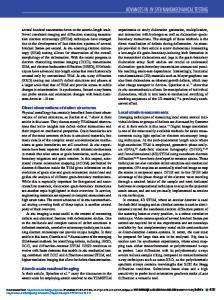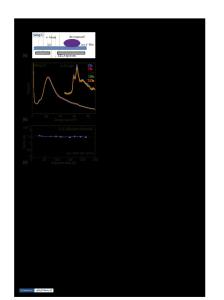In situ nanomechanical testing of twinned metals in a transmission electron microscope
- PDF / 1,395,619 Bytes
- 9 Pages / 585 x 783 pts Page_size
- 44 Downloads / 558 Views
Introduction As a geometrically simple defect boundary, a twin boundary (TB) is created if one-half of the crystal is rotated by π about an axis normal to the twin plane or about the shear direction in the twinning plane.1,2 Metals with a high density of coherent twin boundaries (CTBs) (see the Introductory article in this issue) have an unusual combination of mechanical and physical properties, including high strength,3–6 enhanced ductility,7–9 fatigue resistance,10–13 high electrical conductivity,14,15 good thermal stability,16–18 and radiation tolerance.19–22 Extensive studies based on molecular dynamics (MD) simulations have been applied to investigate the interactions between glide dislocations and TBs,23–29 and TB-related plastic deformation.30,31 The simulations reveal the complexity of the interactions that changes with the Burgers vectors of the dislocations, local stress and strain state,32 etc. For example, under applied shear stress, a screw dislocation could cross-slip either on the CTB plane or transmit onto the complementary glide plane in the twin.23 In contrast, a mixed dislocation is inclined to transfer from a {111} plane to a mirror {111} plane in the twin under a similar shear configuration,24 but transfer to a {100} plane under biaxial loading.26 Although MD simulations have the ability to reveal the mechanisms of dislocation-TB interactions at the atomistic level, the extremely high strain rates and limited time scales used in these simulations are different from those in experimental
studies. Conventional ex situ microscopy studies on deformed specimens do not reveal sufficient details on defect-TB interactions to understand the deformation mechanisms of twinned metals. In situ nanomechanical testing inside a transmission electron microscope (TEM) can visualize individual dynamic interactions during deformation and, therefore, becomes one of the ideal tools for bridging microscopic defect evolution with macroscopic mechanical response. In the last two decades, in situ nanomechanical techniques enabled by TEM have been extensively supported by the advent of the focused ion beam technique (a prominent TEM sample-preparation tool) and the development of microelectromechanical systems (MEMS). The integration of sophisticated MEMS devices, actuators, and sensors into TEM holders enables the application of multiple stress states, such as tension, compression, or bending, for nanomechanical testing. A wealth of novel deformation mechanisms have been probed and verified through this technique,33–37 including dislocation nucleation from either internal boundaries or free surfaces,38–41 grain-boundary-mediated plasticity,42–46 confined layer slip,47 dislocation source starvation,48 mechanical annealing/cyclic loading-enhanced annealing,49–51 deformation twinning in hexagonal close-packed (hcp) metals,52–56 phase transformation,57–59 and surface-diffusion-mediated
Nan Li, Center for Integrated Nanotechnologies, Los Alamos National Laboratory, USA; [email protected] Jiangwei Wang, Center of Electron Microsco
Data Loading...











